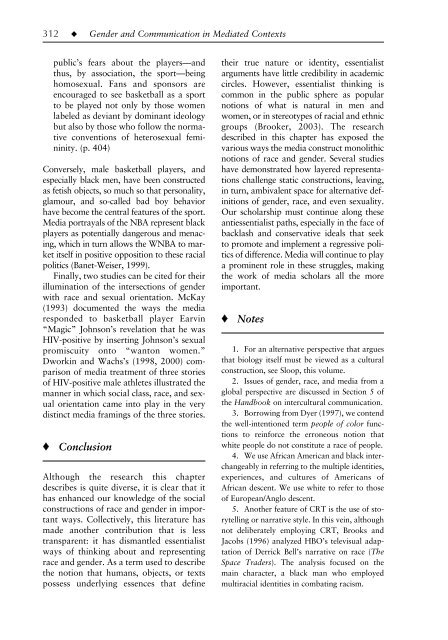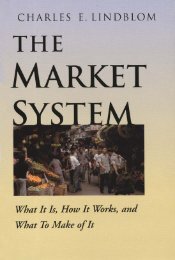Gender, race, and media representation - afghan
Gender, race, and media representation - afghan
Gender, race, and media representation - afghan
You also want an ePaper? Increase the reach of your titles
YUMPU automatically turns print PDFs into web optimized ePapers that Google loves.
16-Dow-4973.qxd 6/11/2006 1:42 PM Page 312<br />
312–––◆–––<strong>Gender</strong> <strong>and</strong> Communication in Mediated Contexts<br />
public’s fears about the players—<strong>and</strong><br />
thus, by association, the sport—being<br />
homosexual. Fans <strong>and</strong> sponsors are<br />
encouraged to see basketball as a sport<br />
to be played not only by those women<br />
labeled as deviant by dominant ideology<br />
but also by those who follow the normative<br />
conventions of heterosexual femininity.<br />
(p. 404)<br />
Conversely, male basketball players, <strong>and</strong><br />
especially black men, have been constructed<br />
as fetish objects, so much so that personality,<br />
glamour, <strong>and</strong> so-called bad boy behavior<br />
have become the central features of the sport.<br />
Media portrayals of the NBA represent black<br />
players as potentially dangerous <strong>and</strong> menacing,<br />
which in turn allows the WNBA to market<br />
itself in positive opposition to these racial<br />
politics (Banet-Weiser, 1999).<br />
Finally, two studies can be cited for their<br />
illumination of the intersections of gender<br />
with <strong>race</strong> <strong>and</strong> sexual orientation. McKay<br />
(1993) documented the ways the <strong>media</strong><br />
responded to basketball player Earvin<br />
“Magic” Johnson’s revelation that he was<br />
HIV-positive by inserting Johnson’s sexual<br />
promiscuity onto “wanton women.”<br />
Dworkin <strong>and</strong> Wachs’s (1998, 2000) comparison<br />
of <strong>media</strong> treatment of three stories<br />
of HIV-positive male athletes illustrated the<br />
manner in which social class, <strong>race</strong>, <strong>and</strong> sexual<br />
orientation came into play in the very<br />
distinct <strong>media</strong> framings of the three stories.<br />
♦ Conclusion<br />
Although the research this chapter<br />
describes is quite diverse, it is clear that it<br />
has enhanced our knowledge of the social<br />
constructions of <strong>race</strong> <strong>and</strong> gender in important<br />
ways. Collectively, this literature has<br />
made another contribution that is less<br />
transparent: it has dismantled essentialist<br />
ways of thinking about <strong>and</strong> representing<br />
<strong>race</strong> <strong>and</strong> gender. As a term used to describe<br />
the notion that humans, objects, or texts<br />
possess underlying essences that define<br />
their true nature or identity, essentialist<br />
arguments have little credibility in academic<br />
circles. However, essentialist thinking is<br />
common in the public sphere as popular<br />
notions of what is natural in men <strong>and</strong><br />
women, or in stereotypes of racial <strong>and</strong> ethnic<br />
groups (Brooker, 2003). The research<br />
described in this chapter has exposed the<br />
various ways the <strong>media</strong> construct monolithic<br />
notions of <strong>race</strong> <strong>and</strong> gender. Several studies<br />
have demonstrated how layered <strong>representation</strong>s<br />
challenge static constructions, leaving,<br />
in turn, ambivalent space for alternative definitions<br />
of gender, <strong>race</strong>, <strong>and</strong> even sexuality.<br />
Our scholarship must continue along these<br />
antiessentialist paths, especially in the face of<br />
backlash <strong>and</strong> conservative ideals that seek<br />
to promote <strong>and</strong> implement a regressive politics<br />
of difference. Media will continue to play<br />
a prominent role in these struggles, making<br />
the work of <strong>media</strong> scholars all the more<br />
important.<br />
♦ Notes<br />
1. For an alternative perspective that argues<br />
that biology itself must be viewed as a cultural<br />
construction, see Sloop, this volume.<br />
2. Issues of gender, <strong>race</strong>, <strong>and</strong> <strong>media</strong> from a<br />
global perspective are discussed in Section 5 of<br />
the H<strong>and</strong>book on intercultural communication.<br />
3. Borrowing from Dyer (1997), we contend<br />
the well-intentioned term people of color functions<br />
to reinforce the erroneous notion that<br />
white people do not constitute a <strong>race</strong> of people.<br />
4. We use African American <strong>and</strong> black interchangeably<br />
in referring to the multiple identities,<br />
experiences, <strong>and</strong> cultures of Americans of<br />
African descent. We use white to refer to those<br />
of European/Anglo descent.<br />
5. Another feature of CRT is the use of storytelling<br />
or narrative style. In this vein, although<br />
not deliberately employing CRT, Brooks <strong>and</strong><br />
Jacobs (1996) analyzed HBO’s televisual adaptation<br />
of Derrick Bell’s narrative on <strong>race</strong> (The<br />
Space Traders). The analysis focused on the<br />
main character, a black man who employed<br />
multiracial identities in combating racism.




